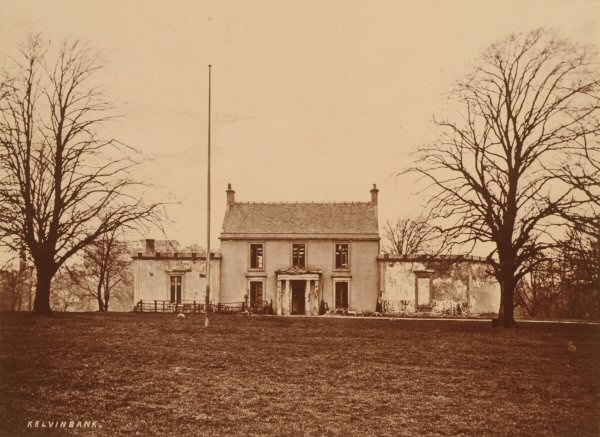

KELVINBANK HOUSE is situated on the north side of the road to Partick, and a few hundred yards west from what is now Kelvingrove Street, leading to the south-west gate of the West End Park. The House faces south. The lands of Kelvinbank, on which it stands, extended to twelve acres, and are bounded on the north by the river Kelvin and on the east by Kelvingrove Street. They were originally part of the lands of Nether Newton, which anciently comprehended what is now the low part of the West End Park, and extended eastwards as far as Saint George's and Woodlands Roads.
The House was built about 1780, and was sold, along with the land, in 1792, to John Wilson, jun. He entered the Faculty of Procurators in 1771, and was, afterwards, many years Town-Clerk of Glasgow, The price of the whole was only £1,000. Mr. Wilson was also a large proprietor within the City. One edifice of his, in particular, is worth mentioning, viz., the house on the south side of Argyle Street, second east from Dunlop Street. This now sadly altered, but once splendid, building was erected about 1750 by Colin Dunlop of Carmyle, Lord Provost in 1770, for his town residence, and is now the only ancient mansion house left in Argyle Street. Mr. Wilson bought it in 1800, and it was long afterwards popularly known as "Town-Clerk Wilson's Land." It still belongs to his representatives.
Mr. Wilson's nephew, William Rae Wilson, LL.D., the celebrated traveller, succeeded him in Kelvinbank and his other properties. This gentleman's proper name was William Rae, but on succeeding to his uncle he assumed the additional surname of Wilson. He married Frances, daughter of John Phillips of Stobcross (which see), but had no family.
As a proof of the enormous rise in the value of land in the Kelvinbank district, Dr. Wilson's representatives sold Kelvinbank House and grounds in 1846 to the Trades' House for £19,640, being nineteen times more than John Wilson paid for them fifty-four years previously.
[1878.]
The rise in value has gone on till the Trades' House have ended by clearing from Kelvinbank £80,000, being four times its price thirty years, and eighty times its price one hundred years, ago. Part of the lands they feued off for building, and the remainder, about six acres, they sold to the Town.
Besides this purchase of Kelvinbank from the Trades' House, the Town has bought from the Incorporation of Bakers the Clayslap Mill, and from the College the triangle extending west from there to the Kelvin Bridge. Clayslap, originally a small snuff-mill, had belonged to the Town once before, and had been in 1771 bought by the Bakers as an addition to their adjoining works, the old Mill of Partick and the old Archbishop's Mill. The triangle had been bought by the College as the site of their new Hospital, and then excambed with the Town for the much superior site of Donaldshill. These three purchases from the Trades' House, the Hakers, and the College now form a beautiful addition to the Park. Kelvinbank has disappeared so completely - House and offices and fences, and the very contour of the ground and the surroundings been so changed - that Town-Clerk Wilson might pass it without knowing.
Back to Contents